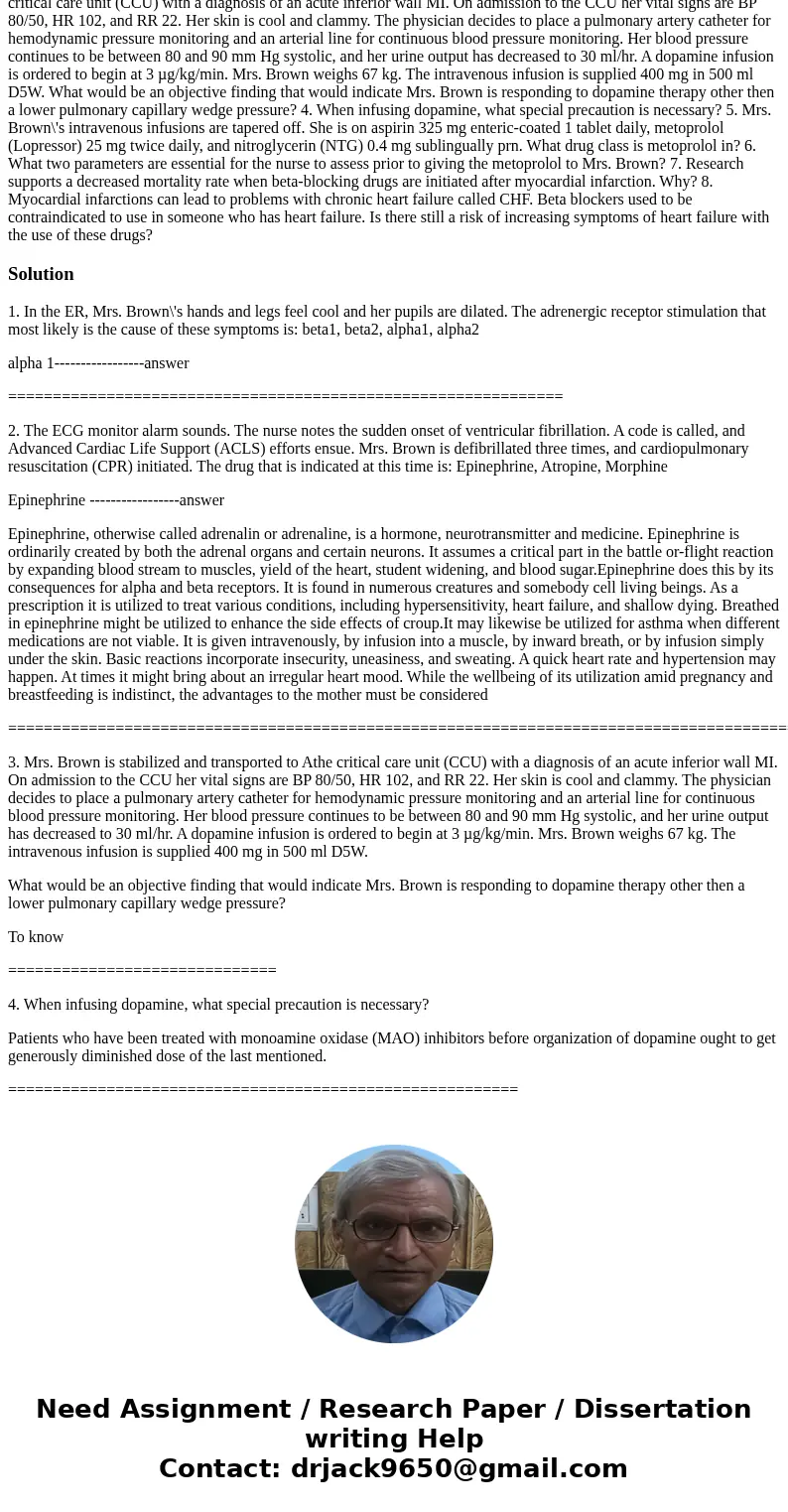2 Mrs Brown is 65 She is widowed lives alone and has two sup
2. Mrs. Brown is 65. She is widowed, lives alone, and has two supportive children who live 1 hour away. She has a history of arthritis and hypertension managed with hydrochlorothiazide (HCTZ) 25 mg daily. Two weeks ago she was treated for bleeding in the upper gastrointestinal tract attributed to use of nonsteroidal anti-inflammatory drugs (NSAIDs). On the morning of admission, she awoke with a strong feeling of indigestion. She took Pepto-Bismol and Tums, but the feeling persisted. She also felt more tired and \"winded.\" She drove herself to the hospital 12 hours after the onset of pain, and the emergency room (ER) nurse recommended that an electro-cardiograph (ECG) be obtained. ST wave elevations were noted in leads II, III, and AVF, indicating injury to the inferior wall of her heart. Note the long duration of time between the onset of symptoms of myocardial infarction and her arrival in the ER as well as her recent gastrointestinal bleeding. These factors contraindicate the use of fibrinolytic therapy in the setting of her acute coronary syndrome. 1. In the ER, Mrs. Brown\'s hands and legs feel cool and her pupils are dilated. The adrenergic receptor stimulation that most likely is the cause of these symptoms is: beta1, beta2, alpha1, alpha2 2. The ECG monitor alarm sounds. The nurse notes the sudden onset of ventricular fibrillation. A code is called, and Advanced Cardiac Life Support (ACLS) efforts ensue. Mrs. Brown is defibrillated three times, and cardiopulmonary resuscitation (CPR) initiated. The drug that is indicated at this time is: Epinephrine, Atropine, Morphine 3. Mrs. Brown is stabilized and transported to Athe critical care unit (CCU) with a diagnosis of an acute inferior wall MI. On admission to the CCU her vital signs are BP 80/50, HR 102, and RR 22. Her skin is cool and clammy. The physician decides to place a pulmonary artery catheter for hemodynamic pressure monitoring and an arterial line for continuous blood pressure monitoring. Her blood pressure continues to be between 80 and 90 mm Hg systolic, and her urine output has decreased to 30 ml/hr. A dopamine infusion is ordered to begin at 3 µg/kg/min. Mrs. Brown weighs 67 kg. The intravenous infusion is supplied 400 mg in 500 ml D5W. What would be an objective finding that would indicate Mrs. Brown is responding to dopamine therapy other then a lower pulmonary capillary wedge pressure? 4. When infusing dopamine, what special precaution is necessary? 5. Mrs. Brown\'s intravenous infusions are tapered off. She is on aspirin 325 mg enteric-coated 1 tablet daily, metoprolol (Lopressor) 25 mg twice daily, and nitroglycerin (NTG) 0.4 mg sublingually prn. What drug class is metoprolol in? 6. What two parameters are essential for the nurse to assess prior to giving the metoprolol to Mrs. Brown? 7. Research supports a decreased mortality rate when beta-blocking drugs are initiated after myocardial infarction. Why? 8. Myocardial infarctions can lead to problems with chronic heart failure called CHF. Beta blockers used to be contraindicated to use in someone who has heart failure. Is there still a risk of increasing symptoms of heart failure with the use of these drugs?
Solution
1. In the ER, Mrs. Brown\'s hands and legs feel cool and her pupils are dilated. The adrenergic receptor stimulation that most likely is the cause of these symptoms is: beta1, beta2, alpha1, alpha2
alpha 1-----------------answer
==============================================================
2. The ECG monitor alarm sounds. The nurse notes the sudden onset of ventricular fibrillation. A code is called, and Advanced Cardiac Life Support (ACLS) efforts ensue. Mrs. Brown is defibrillated three times, and cardiopulmonary resuscitation (CPR) initiated. The drug that is indicated at this time is: Epinephrine, Atropine, Morphine
Epinephrine -----------------answer
Epinephrine, otherwise called adrenalin or adrenaline, is a hormone, neurotransmitter and medicine. Epinephrine is ordinarily created by both the adrenal organs and certain neurons. It assumes a critical part in the battle or-flight reaction by expanding blood stream to muscles, yield of the heart, student widening, and blood sugar.Epinephrine does this by its consequences for alpha and beta receptors. It is found in numerous creatures and somebody cell living beings. As a prescription it is utilized to treat various conditions, including hypersensitivity, heart failure, and shallow dying. Breathed in epinephrine might be utilized to enhance the side effects of croup.It may likewise be utilized for asthma when different medications are not viable. It is given intravenously, by infusion into a muscle, by inward breath, or by infusion simply under the skin. Basic reactions incorporate insecurity, uneasiness, and sweating. A quick heart rate and hypertension may happen. At times it might bring about an irregular heart mood. While the wellbeing of its utilization amid pregnancy and breastfeeding is indistinct, the advantages to the mother must be considered
===============================================================================================
3. Mrs. Brown is stabilized and transported to Athe critical care unit (CCU) with a diagnosis of an acute inferior wall MI. On admission to the CCU her vital signs are BP 80/50, HR 102, and RR 22. Her skin is cool and clammy. The physician decides to place a pulmonary artery catheter for hemodynamic pressure monitoring and an arterial line for continuous blood pressure monitoring. Her blood pressure continues to be between 80 and 90 mm Hg systolic, and her urine output has decreased to 30 ml/hr. A dopamine infusion is ordered to begin at 3 µg/kg/min. Mrs. Brown weighs 67 kg. The intravenous infusion is supplied 400 mg in 500 ml D5W.
What would be an objective finding that would indicate Mrs. Brown is responding to dopamine therapy other then a lower pulmonary capillary wedge pressure?
To know
==============================
4. When infusing dopamine, what special precaution is necessary?
Patients who have been treated with monoamine oxidase (MAO) inhibitors before organization of dopamine ought to get generously diminished dose of the last mentioned.
=========================================================


 Homework Sourse
Homework Sourse